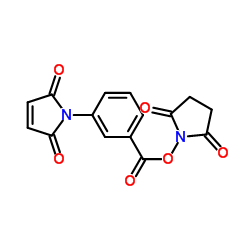MBS Crosslinker

MBS Crosslinker structure
|
Common Name | MBS Crosslinker | ||
|---|---|---|---|---|
| CAS Number | 58626-38-3 | Molecular Weight | 314.250 | |
| Density | 1.6±0.1 g/cm3 | Boiling Point | 524.5±52.0 °C at 760 mmHg | |
| Molecular Formula | C15H10N2O6 | Melting Point | 175-177 °C(lit.) | |
| MSDS | USA | Flash Point | 271.0±30.7 °C | |
| Symbol |

GHS07 |
Signal Word | Warning | |
|
Assembly of Slx4 signaling complexes behind DNA replication forks.
EMBO J. 34 , 2182-97, (2015) Obstructions to replication fork progression, referred to collectively as DNA replication stress, challenge genome stability. In Saccharomyces cerevisiae, cells lacking RTT107 or SLX4 show genome instability and sensitivity to DNA replication stress and are d... |
|
|
The Cell Adhesion Molecule Necl-4/CADM4 Serves as a Novel Regulator for Contact Inhibition of Cell Movement and Proliferation.
PLoS ONE 10(4) , e0124259, (2015) Contact inhibition of cell movement and proliferation is critical for proper organogenesis and tissue remodeling. We show here a novel regulatory mechanism for this contact inhibition using cultured vascular endothelial cells. When the cells were confluently ... |
|
|
The impact of carbon nanomaterials on the development of phenanthrene catabolism in soil.
Environ. Sci. Process. Impacts 17 , 1302-10, (2015) This study investigates the impact of different types of carbon nanomaterials (CNMs) namely C60, multi-walled carbon nanotubes (MWCNTs) and fullerene soot on the catabolism of (14)C-phenanthrene in soil by indigenous microorganisms. Different concentrations (... |
|
|
Arabidopsis RIC1 Severs Actin Filaments at the Apex to Regulate Pollen Tube Growth.
Plant Cell 27 , 1140-61, (2015) Pollen tubes deliver sperms to the ovule for fertilization via tip growth. The rapid turnover of F-actin in pollen tube tips plays an important role in this process. In this study, we demonstrate that Arabidopsis thaliana RIC1, a member of the ROP-interactive... |
|
|
High-dose Ionizing Radiation Regulates Gene Expression Changes in the MCF7 Breast Cancer Cell Line.
Anticancer Res. 35 , 2577-91, (2015) Intraoperative electron radiation therapy (IOERT) is a therapeutic technique which administers a single high dose of ionizing radiation immediately after surgical tumor removal. IOERT induces a strong stress response: both tumor and normal cells activating pr... |
|
|
Profibrogenic phenotype in caveolin-1 deficiency via differential regulation of STAT-1/3 proteins.
Biochem. Cell Biol. 92(5) , 370-8, (2014) Fibrosis underlies the pathogenesis of several human diseases, which can lead to severe injury of vital organs. We previously demonstrated that caveolin-1 expression is reduced in experimental fibrosis and that caveolin-1 exerts antiproliferative and antifibr... |
|
|
Phosphatidylinositol-glycan-phospholipase D is involved in neurodegeneration in prion disease.
PLoS ONE 10(4) , e0122120, (2015) PrPSc is formed from a normal glycosylphosphatidylinositol (GPI)-anchored prion protein (PrPC) by a posttranslational modification. Most GPI-anchored proteins have been shown to be cleaved by GPI phospholipases. Recently, GPI-phospholipase D (GPI-PLD) was sho... |
|
|
Regulation of HbPIP2;3, a Latex-Abundant Water Transporter, Is Associated with Latex Dilution and Yield in the Rubber Tree (Hevea brasiliensis Muell. Arg.).
PLoS ONE 10 , e0125595, (2015) Rubber tree (Hevea brasiliensis) latex, the source of natural rubber, is synthesised in the cytoplasm of laticifers. Efficient water inflow into laticifers is crucial for latex flow and production since it is the determinant of the total solid content of late... |
|
|
The OB-fold domain 1 of human POT1 recognizes both telomeric and non-telomeric DNA motifs.
Biochimie 115 , 17-27, (2015) The POT1 protein plays a critical role in telomere protection and telomerase regulation. POT1 binds single-stranded 5'-TTAGGGTTAG-3' and forms a dimer with the TPP1 protein. The dimer is recruited to telomeres, either directly or as part of the Shelterin comp... |
|
|
Epigenetic modification maintains intrinsic limb-cell identity in Xenopus limb bud regeneration.
Dev. Biol. 406 , 271-82, (2015) Many amphibians can regenerate limbs, even in adulthood. If a limb is amputated, the stump generates a blastema that makes a complete, new limb in a process similar to developmental morphogenesis. The blastema is thought to inherit its limb-patterning propert... |